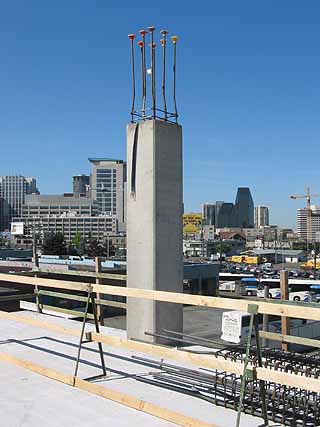|
Subscribe / Renew |
|
|
Contact Us |
|
| ► Subscribe to our Free Weekly Newsletter | |
| home | Welcome, sign in or click here to subscribe. | login |
Construction
| |
 |
June 3, 2005
Special concrete weighs in locally
Skanska

Photo courtesy Skanska
Skanska used consolidated concrete for this column at the Alley24 project in Seattle. The special mix eliminated the need to vibrate the concrete once it was poured into the forms.
|
One of the most important technological advancements in the history of concrete design and production recently made its way to the local development community, and it stands to make a significant impact on the way many commercial projects are built from now on.
Called self-consolidating concrete, this technology was originally developed overseas in the mid-1980s to address concerns by the Japanese government over concrete's durability in the commercial building environment.
Over the past 20 years, self-consolidating concrete (SCC) has been widely used in a number of critical construction applications in Asia, Western Europe and parts of the United States. But, despite its popularity around the world, only recently did the specially formulated mix of concrete paste, aggregate and chemical compounds — called viscosity-modifying admixtures — gain acceptance among local builders and developers.
Today, a number of local contractors rely consistently on SCC for its economies of scale, most notably in its ability to reduce time and labor within large-project commercial construction applications.
SCC has been shown to dramatically decrease costs associated with pouring and placing concrete walls and columns on a wide range of commercial-office and residential mixed-use projects. Skanska has realized an up to 50 percent increase in production on several projects where it's used Cadman's PerformX mix, including Lincoln Square in downtown Bellevue and Alley24 in Seattle's South Lake Union neighborhood.
Unlike traditional structural-grade concrete, the highly dense SCC requires no vibration during pour and placement, enabling workers to begin filling additional concrete forms or move on to other areas of production while concrete is pumped into the building's formwork. And since SCC is so workable and malleable in its original state — it's so fluid, slump-flow testing is used in place of standard slump tests — the mix moves and consolidates effortlessly around rebar and other structural elements within the narrow, often congested concrete forms.
The easy flowing feature promotes a safer work environment because it eliminates the need for workers to climb onto the formwork to vibrate the concrete into place. Project neighbors also appreciate the advanced concrete mix as it creates a significantly quieter jobsite, devoid of vibrators and other loud heavy equipment.
SCC is so dense and fluid-like in its consistency that it can be easily placed in forms from a single pour location. In addition, self-consolidating concrete can routinely flow more than 100 feet horizontally, saving developers on overall construction time and eliminating costs associated with equipment leasing and on-site labor.
Aside from being more convenient to use on select commercial buildings — it ends up being most economical for mid- and high-rise projects — SCC also provides several other structural and aesthetic benefits.
SCC is significantly stronger and less dependent on external environmental circumstances than typical structural-grade concrete mixes, especially in the early stages of curing. SCC has been shown to achieve very high early strength — two-day strength tests on PerformX have exceeded 4,000 psi; 28-day tests have rendered more than 8,000 psi — enabling much earlier form removal and faster production schedules.
Other performance-based benefits of self-consolidating concrete include a dramatic reduction in time required for patching and sacking the poured columns and walls. In some cases, SCC has enabled contractors to spend up to 95 percent less time eliminating the typical "bug holes" caused by air seeping into the concrete during vibration, or covering up rock particles that typically travel to the lower end of the vertical columns after separating prematurely from the concrete paste. And, by eliminating the risk of air or rock pockets getting into the dense concrete mix, SCC helps prevent corrosion from forming around the various metal-based materials placed within the project's walls, columns or slabs.
Self-consolidating concrete can also be used for slab-on-grade construction. The benefits in using this mix for large flatwork applications are that it can eliminate the need for raking and screeding, saving time and money.
Since its inception centuries ago, concrete has benefited from considerable advancements in technology and manufacturing that have paved the way for a safer and more productive construction environment. Nowhere have those advances been more significant than the development of self-consolidating concrete. Once relegated to builders outside the Northwest, this product has forever altered how local projects will be built. Most important, SCC has increased construction quality while saving money.
Gerard McGlynn is a superintendent at Skanska. He is responsible for all retail-structure and architectural concrete work at Lincoln Square.
Other Stories:
- Skagit County town's history is rich in Concrete
- Is your mine ready for an extreme makeover?
- Pump up your concrete strength with slag


